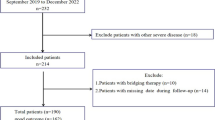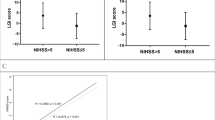Abstract
Tumor necrosis factor-a-induced protein 8-like 2 (TIPE2) is a novel negative regulator for maintaining immune homeostasis. This study aimed to investigate TIPE2 mRNA in peripheral blood mononuclear cells for predicting 3-month functional outcomes and mortality of patients with acute ischemic stroke. A total of 182 consecutive patients were prospective collected, and there were 55 (30.2%) patients with unfavorable outcome and 33 (18.1%) patients died at the end of 3 months. The area under the operating characteristic curve (AUC) for TIPE2 mRNA was 0.810 (95% CI 0.733–0.886) for mortality and 0.740 (95% CI 0.662–0.818) for unfavorable outcome. The model incorporating National Institutes of Health Stroke Scale (NIHSS) plus TIPE2 showed significantly (P = 0.04) increased discrimination power (AUC = 0.925, 95% CI 0.874–0.976) for mortality than NIHSS (AUC = 0.882, 95% CI 0.833–0.932). Furthermore, NIHSS plus TIPE2 showed a significant improvement of both integrated discrimination index (IDI) and net reclassification index (NRI) as compared with NIHSS (IDI = 0.224, 95% CI 0.150–0.299, P < 0.001; NRI = 1.119, 95% CI 0.810–1.429, P < 0.001). The pruned time-dependent tree analysis showed that patients with NIHSS ≥ 5.5 and TIPE2 mRNA < 5.2 had rather high 3-month mortality. In conclusion, TIPE2 mRNA improved the diagnostic value of NIHSS score, and patients with NIHSS ≥ 5.5 and TIPE2 mRNA < 5.2 had high 3-month mortality.




Similar content being viewed by others
References
Tu WJ, Zeng XW, Deng A, Zhao SJ, Luo DZ, Ma GZ, Wang H, Liu Q (2017) Circulating FABP4 (fatty acid—binding protein 4) is a novel prognostic biomarker in patients with acute ischemic stroke. Stroke 48(6):1531–1538. https://doi.org/10.1161/STROKEAHA.117.017128
Sisirak V, Sally B, D’Agati V, Martinez-Ortiz W, Ozcakar ZB, David J, Rashidfarrokhi A, Yeste A, Panea C, Chida AS, Bogunovic M, Ivanov II, Quintana FJ, Sanz I, Elkon KB, Tekin M, Yalcinkaya F, Cardozo TJ, Clancy RM, Buyon JP, Reizis B (2016) Digestion of chromatin in apoptotic cell microparticles prevents autoimmunity. Cell 166(1):88–101. https://doi.org/10.1016/j.cell.2016.05.034
Esenwa CC, Elkind MS (2016) Inflammatory risk factors, biomarkers and associated therapy in ischaemic stroke. Nat Rev Neurol 12(10):594–604. https://doi.org/10.1038/nrneurol.2016.125
Sun H, Gong S, Carmody RJ, Hilliard A, Li L, Sun J, Kong L, Xu L, Hilliard B, Hu S, Shen H, Yang X, Chen YH (2008) TIPE2, a negative regulator of innate and adaptive immunity that maintains immune homeostasis. Cell 133(3):415–426. https://doi.org/10.1016/j.cell.2008.03.026
Zhang Y, Wei X, Liu L, Liu S, Wang Z, Zhang B, Fan B, Yang F, Huang S, Jiang F, Chen YH, Yi F (2012) TIPE2, a novel regulator of immunity, protects against experimental stroke. J Biol Chem 287(39):32546–32555. https://doi.org/10.1074/jbc.M112.348755
Li D, Song L, Fan Y, Li X, Li Y, Chen J, Zhu F, Guo C, Shi Y, Zhang L (2009) Down-regulation of TIPE2 mRNA expression in peripheral blood mononuclear cells from patients with systemic lupus erythematosus. Clin Immunol 133(3):422–427. https://doi.org/10.1016/j.clim.2009.08.014
Xi W, Hu Y, Liu Y, Zhang J, Wang L, Lou Y, Qu Z, Cui J, Zhang G, Liang X, Ma C, Gao C, Chen Y, Liu S (2011) Roles of TIPE2 in hepatitis B virus-induced hepatic inflammation in humans and mice. Mol Immunol 48(9–10):1203–1208. https://doi.org/10.1016/j.molimm.2011.03.002
Kong L, Liu K, Zhang YZ, Jin M, Wu BR, Wang WZ, Li W, Nan YM, Chen YH (2013) Downregulation of TIPE2 mRNA expression in peripheral blood mononuclear cells from patients with chronic hepatitis C. Hepatol Int 7(3):844–849. https://doi.org/10.1007/s12072-013-9435-2
Wang LY, Fan YC, Zhao J, Gao S, Sun FK, Han J, Yang Y, Wang K (2014) Elevated expression of tumour necrosis factor-alpha-induced protein 8 (TNFAIP8)-like 2 mRNA in peripheral blood mononuclear cells is associated with disease progression of acute-on-chronic hepatitis B liver failure. J Viral Hepat 21(1):64–73. https://doi.org/10.1111/jvh.12116
Zhao Q, Zhao M, Dong T, Zhou C, Peng Y, Zhou X, Fan B, Ma W, Han M, Liu S (2015) Tumor necrosis factor-alpha-induced protein-8 like-2 (TIPE2) upregulates p27 to decrease gastic cancer cell proliferation. J Cell Biochem 116(6):1121–1129. https://doi.org/10.1002/jcb.25068
Li Y, Li X, Liu G, Sun R, Wang L, Wang J, Wang H (2015) Downregulated TIPE2 is associated with poor prognosis and promotes cell proliferation in non-small cell lung cancer. Biochem Biophys Res Commun 457(1):43–49. https://doi.org/10.1016/j.bbrc.2014.12.080
Liu QQ, Zhang FF, Wang F, Qiu JH, Luo CH, Zhu GY, Liu YF (2015) TIPE2 inhibits lung cancer growth attributing to promotion of apoptosis by regulating some apoptotic molecules expression. PLoS One 10(5):e0126176. https://doi.org/10.1371/journal.pone.0126176
Cao X, Zhang L, Shi Y, Sun Y, Dai S, Guo C, Zhu F, Wang Q, Wang J, Wang X, Chen YH, Zhang L (2013) Human tumor necrosis factor (TNF)-alpha-induced protein 8-like 2 suppresses hepatocellular carcinoma metastasis through inhibiting Rac1. Mol Cancer 12(1):149. https://doi.org/10.1186/1476-4598-12-149
Zhang Z, Qi H, Hou S, Jin X (2013) TIPE2 mRNA overexpression correlates with TNM staging in renal cell carcinoma tissues. Oncol Lett 6(2):571–575. https://doi.org/10.3892/ol.2013.1388
Li XM, Su JR, Yan SP, Cheng ZL, Yang TT, Zhu Q (2014) A novel inflammatory regulator TIPE2 inhibits TLR4-mediated development of colon cancer via caspase-8. Cancer Biomark 14(4):233–240. https://doi.org/10.3233/CBM-140402
Zhang S, Zhang Y, Wei X, Zhen J, Wang Z, Li M, Miao W, Ding H, Du P, Zhang W, He M, Yi F (2010) Expression and regulation of a novel identified TNFAIP8 family is associated with diabetic nephropathy. Biochim Biophys Acta 1802(11):1078–1086. https://doi.org/10.1016/j.bbadis.2010.08.003
Ma Y, Liu X, Wei Z, Wang X, Wang Z, Zhong W, Li Y, Zhu F, Guo C, Zhang L, Wang X (2013) The expression and significance of TIPE2 in peripheral blood mononuclear cells from asthmatic children. Scand J Immunol 78(6):523–528. https://doi.org/10.1111/sji.12110
Fan YC, Wang N, Sun YY, Xiao XY, Wang K (2015) TIPE2 mRNA level in PBMCs serves as a novel biomarker for predicting short-term mortality of acute-on-chronic hepatitis B liver failure: a prospective single-center study. Medicine (Baltimore) 94(39):e1638. https://doi.org/10.1097/MD.0000000000001638
Jia L, Gui B, Tian P, Yao G, Fu R, Wang L, Ge H, Ou Y (2013) TIPE2, a novel biomarker for clinical chronic kidney allograft rejection. Artif Organs 37(2):221–225. https://doi.org/10.1111/j.1525-1594.2012.01527.x
Boehme AK, Esenwa C, Elkind MS (2017) Stroke risk factors, genetics, and prevention. Circ Res 120(3):472–495. https://doi.org/10.1161/CIRCRESAHA.116.308398
Tsivgoulis G, Patousi A, Pikilidou M, Birbilis T, Katsanos AH, Mantatzis M, Asimis A, Papanas N, Skendros P, Terzoudi A, Karamanli A, Kouroumichakis I, Zebekakis P, Maltezos E, Piperidou C, Vadikolias K, Heliopoulos I (2018) Stroke incidence and outcomes in Northeastern Greece: the Evros Stroke Registry. Stroke 49(2):288–295. https://doi.org/10.1161/STROKEAHA.117.019524
Brott T, Adams HP Jr, Olinger CP, Marler JR, Barsan WG, Biller J, Spilker J, Holleran R, Eberle R, Hertzberg V et al (1989) Measurements of acute cerebral infarction: a clinical examination scale. Stroke 20(7):864–870
Adams HP Jr, Bendixen BH, Kappelle LJ, Biller J, Love BB, Gordon DL, Marsh EE 3rd (1993) Classification of subtype of acute ischemic stroke. Definitions for use in a multicenter clinical trial. TOAST. Trial of Org 10172 in Acute Stroke Treatment. Stroke 24(1):35–41
Ilzecka J, Stelmasiak Z (2000) Practical significance of ischemic stroke OCSP (Oxfordshire Community Stroke Project) classification. Neurol Neurochir Pol 34(1):11–22
Sims JR, Gharai LR, Schaefer PW, Vangel M, Rosenthal ES, Lev MH, Schwamm LH (2009) ABC/2 for rapid clinical estimate of infarct, perfusion, and mismatch volumes. Neurology 72(24):2104–2110. https://doi.org/10.1212/WNL.0b013e3181aa5329
Bonita R, Beaglehole R (1988) Recovery of motor function after stroke. Stroke 19(12):1497–1500
Katan M, Fluri F, Morgenthaler NG, Schuetz P, Zweifel C, Bingisser R, Muller K, Meckel S, Gass A, Kappos L, Steck AJ, Engelter ST, Muller B, Christ-Crain M (2009) Copeptin: a novel, independent prognostic marker in patients with ischemic stroke. Ann Neurol 66(6):799–808. https://doi.org/10.1002/ana.21783
Palm F, Pussinen PJ, Safer A, Tervahartiala T, Sorsa T, Urbanek C, Becher H, Grau AJ (2018) Serum matrix metalloproteinase-8, tissue inhibitor of metalloproteinase and myeloperoxidase in ischemic stroke. Atherosclerosis 271:9–14. https://doi.org/10.1016/j.atherosclerosis.2018.02.012
Wu H, Guo P, Jin Z, Li X, Yang X, Tang C, Wang Y, Ke J (2018) Serum levels of irisin predict short-term outcomes in ischemic stroke. Cytokine. https://doi.org/10.1016/j.cyto.2018.02.017
Amantea D, Nappi G, Bernardi G, Bagetta G, Corasaniti MT (2009) Post-ischemic brain damage: pathophysiology and role of inflammatory mediators. FEBS J 276(1):13–26. https://doi.org/10.1111/j.1742-4658.2008.06766.x
Xia W, Han J, Huang G, Ying W (2010) Inflammation in ischaemic brain injury: current advances and future perspectives. Clin Exp Pharmacol Physiol 37(2):253–258. https://doi.org/10.1111/j.1440-1681.2009.05279.x
Suzuki S, Tanaka K, Suzuki N (2009) Ambivalent aspects of interleukin-6 in cerebral ischemia: inflammatory versus neurotrophic aspects. J Cereb Blood Flow Metab 29(3):464–479. https://doi.org/10.1038/jcbfm.2008.141
Chun HJ, Zheng L, Ahmad M, Wang J, Speirs CK, Siegel RM, Dale JK, Puck J, Davis J, Hall CG, Skoda-Smith S, Atkinson TP, Straus SE, Lenardo MJ (2002) Pleiotropic defects in lymphocyte activation caused by caspase-8 mutations lead to human immunodeficiency. Nature 419(6905):395–399. https://doi.org/10.1038/nature01063
Salmena L, Hakem R (2005) Caspase-8 deficiency in T cells leads to a lethal lymphoinfiltrative immune disorder. J Exp Med 202(6):727–732. https://doi.org/10.1084/jem.20050683
Freundt EC, Bidere N, Lenardo MJ (2008) A different TIPE of immune homeostasis. Cell 133(3):401–402. https://doi.org/10.1016/j.cell.2008.04.017
Muruet W, Rudd A, Wolfe CDA, Douiri A (2018) Long-term survival after intravenous thrombolysis for ischemic stroke: a propensity score-matched cohort with up to 10-year follow-up. Stroke 49(3):607–613. https://doi.org/10.1161/STROKEAHA.117.019889
Smith EE, Kent DM, Bulsara KR, Leung LY, Lichtman JH, Reeves MJ, Towfighi A, Whiteley WN, Zahuranec DB, American Heart Association Stroke C (2018) Effect of dysphagia screening strategies on clinical outcomes after stroke: a systematic review for the 2018 guidelines for the early management of patients with acute ischemic stroke. Stroke 49(3):e123–e128. https://doi.org/10.1161/STR.0000000000000159
Acknowledgements
We greatly appreciated the technical assistance with statistical analysis during the revision provided by Prof. Tao Zhang (Department of Biostatistics, School of Public Health, Shandong University), and Dr. Xinglin Chen (EmpowerStat software, developed by the statistician Prof. Chang-Zhong Chen, Harvard University).
Funding
This work was supported by the Grant from the National Natural Science Foundation of China (81373635) and the Key Research and Development Plan of Shandong Province (2016GSF121044).
Author information
Authors and Affiliations
Corresponding author
Ethics declarations
Conflicts of interest
The authors declare that they have no competing interests.
Ethical statement
The study was approved by the local ethics committee of the Jinan Central Hospital affiliated to Shandong University.
Electronic supplementary material
Below is the link to the electronic supplementary material.
Rights and permissions
About this article
Cite this article
Zhang, YY., Huang, NN., Fan, YC. et al. Peripheral tumor necrosis factor-a-induced protein 8-like 2 mRNA level for predicting 3-month mortality of patients with acute ischemic stroke. J Neurol 265, 2573–2586 (2018). https://doi.org/10.1007/s00415-018-9036-z
Received:
Revised:
Accepted:
Published:
Issue Date:
DOI: https://doi.org/10.1007/s00415-018-9036-z




